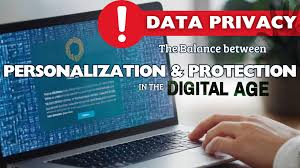Privacy in the Digital Age: Balancing Security and Personal Data
In the digital age, personal data has become a valuable commodity, shaping industries, driving economies, and influencing individuals’ lives. With the rapid growth of digital technologies, the amount of data being collected and stored is unprecedented. From online shopping habits to social media interactions, data is collected at every turn, often without individuals being fully aware. While this data can lead to incredible innovations, including personalized services and enhanced security measures, it also raises significant concerns about privacy.
Balancing the need for security and the protection of personal data has emerged as one of the central challenges of our time. This article explores the complexities of privacy in the digital age, the risks associated with data collection, and how governments, companies, and individuals can address these issues to maintain a balance between privacy and security.
1. The Growth of Data Collection in the Digital Age
The proliferation of digital devices, from smartphones to smart homes, has led to a massive increase in the amount of data generated daily. According to research, more than 2.5 quintillion bytes of data are produced every day, with that number expected to grow as technology becomes even more integrated into daily life.
a. How Data Is Collected
Data collection occurs through various channels, including:
- Web browsing: Websites track user activity, storing data on which pages are visited, for how long, and even what users click on.
- Social media: Platforms like Facebook, Instagram, and Twitter collect detailed information on users’ likes, interests, friends, and interactions.
- Smart devices: Devices like fitness trackers and smart assistants collect real-time data, including health metrics, location data, and voice commands.
- Mobile apps: Applications often ask for access to contacts, photos, and location data, which are sometimes shared with third parties for marketing and analytics purposes.
While much of this data collection happens behind the scenes, individuals are often unaware of the extent of the information being gathered about them. As data becomes increasingly important in driving business strategies and government policies, the lack of transparency surrounding data collection practices has raised concerns about the erosion of personal privacy.
2. The Risks of Digital Data Collection
With the rise in data collection, the risks associated with data privacy have become more apparent. While the collection of personal data can lead to improved services and convenience, it also introduces vulnerabilities that can have significant consequences for individuals and society.
a. Data Breaches
Data breaches have become a growing concern as more personal information is stored online. High-profile breaches at companies like Equifax, Target, and Marriott have exposed the sensitive data of millions of people, leading to identity theft, financial loss, and long-term damage to consumer trust. Hackers often target large datasets, knowing that the more information they can access, the more damage they can inflict.
b. Surveillance and Tracking
In addition to corporate data collection, government surveillance has also expanded in the digital age. National security agencies often collect vast amounts of data from citizens under the guise of protecting public safety. While surveillance can help prevent crime and terrorism, it also raises concerns about the erosion of civil liberties. Mass data collection can lead to an invasion of privacy and the misuse of personal information by governments and law enforcement agencies.
c. Loss of Control Over Personal Data
Many individuals are unaware of how much control they lose over their data once it is collected. Data collected by companies is often shared with third parties, including advertisers and analytics firms, without explicit consent. This can lead to targeted advertising, profiling, and even discrimination. Once data is in the hands of multiple entities, it becomes difficult for individuals to know where their information is being stored, how it’s being used, or whether it can be deleted.
3. The Tension Between Security and Privacy
As digital technologies advance, so does the complexity of balancing security and privacy. In many cases, governments and businesses argue that collecting personal data is necessary for improving security. However, this comes at the cost of personal privacy, creating tension between these two important objectives.
a. Security Measures vs. Privacy Concerns
Enhanced security measures, such as surveillance systems, biometrics, and encryption, have been widely implemented to combat cyber threats, fraud, and terrorism. However, these measures often require access to personal data. For instance:
- Biometric security: Technologies like facial recognition and fingerprint scanning are increasingly used for security purposes. While these methods can enhance protection, they also involve the collection of sensitive biometric data, which, if compromised, could have irreversible consequences.
- Mass surveillance: Governments around the world have implemented surveillance programs to monitor online activity, track potential threats, and ensure public safety. However, these programs often collect data on innocent individuals, raising concerns about overreach and the violation of personal freedoms.
In many cases, individuals are asked to trade their privacy for enhanced security, a dilemma that has sparked intense debate. Should citizens sacrifice some privacy to ensure safety, or is there a way to protect both security and personal data simultaneously?
4. The Role of Regulation and Legislation
In response to growing concerns about data privacy, governments around the world have begun to introduce legislation to protect personal information. These regulations aim to give individuals more control over their data and hold companies accountable for how they collect, store, and use personal information.
a. The General Data Protection Regulation (GDPR)
One of the most significant pieces of data protection legislation is the European Union’s General Data Protection Regulation (GDPR), which came into effect in 2018. The GDPR gives individuals more control over their personal data and imposes strict requirements on businesses regarding data collection and processing. Key features of the GDPR include:
- Right to be informed: Companies must be transparent about how they collect and use personal data.
- Right to access: Individuals have the right to access the data that companies hold about them.
- Right to be forgotten: Individuals can request the deletion of their data if it is no longer necessary for its original purpose.
- Data breach notification: Companies must notify regulators and affected individuals within 72 hours of a data breach.
The GDPR has set a global standard for data privacy, influencing similar legislation in other parts of the world.
b. The California Consumer Privacy Act (CCPA)
In the United States, the California Consumer Privacy Act (CCPA) is another landmark piece of privacy legislation. Passed in 2018, the CCPA gives California residents the right to know what personal data is being collected about them, the ability to opt out of the sale of their data, and the right to request that their data be deleted.
The CCPA has paved the way for other states to consider similar privacy laws, highlighting the growing recognition of the need to protect personal data in the digital age.
5. Best Practices for Protecting Personal Data
While regulations play a crucial role in protecting privacy, individuals must also take proactive steps to safeguard their personal data. Here are some best practices for maintaining privacy in the digital age:
a. Use Strong Passwords and Two-Factor Authentication
Weak passwords are one of the most common ways hackers gain access to personal accounts. To protect your data, use strong, unique passwords for each account, and enable two-factor authentication (2FA) whenever possible. 2FA adds an extra layer of security by requiring a second form of identification, such as a fingerprint or a code sent to your phone.
b. Be Mindful of Data Sharing on Social Media
Social media platforms collect vast amounts of data based on what users share, like, and follow. Be cautious about the information you post online and review your privacy settings to limit who can see your posts. Additionally, consider disabling location tracking and other features that may share more data than you’re comfortable with.
c. Regularly Review App Permissions
Many mobile apps request access to sensitive data, such as your location, contacts, and camera. Before downloading an app, review the permissions it requests and only grant access to the data necessary for the app to function. You can also periodically review the permissions of apps already on your device and revoke access if necessary.
d. Use Virtual Private Networks (VPNs)
A VPN encrypts your internet connection, making it more difficult for hackers and third parties to intercept your data. When using public Wi-Fi or accessing sensitive information online, a VPN can help protect your personal information from unauthorized access.
e. Limit Data Collection by Companies
Many websites and apps collect more data than is necessary for their services. Whenever possible, opt out of unnecessary data collection by reviewing the privacy policies of the platforms you use. Some companies also offer the option to delete your data or opt out of data sharing with third parties.
6. The Future of Privacy in the Digital Age
As technology continues to evolve, the debate over privacy and security will become even more pressing. Innovations like artificial intelligence, the Internet of Things (IoT), and 5G networks will introduce new challenges for data privacy and security. Governments, businesses, and individuals must continue to work together to find a balance that protects both personal data and public safety.
a. AI and Data Privacy
AI relies heavily on data to function, raising questions about how to ensure privacy in a world where algorithms analyze personal information to make decisions. Developing ethical AI systems that prioritize privacy and transparency will be crucial in the years ahead.
b. The Role of Individuals in Protecting Privacy
Ultimately, individuals will need to become more proactive in protecting their own data. As new technologies emerge, staying informed about privacy risks and adopting best practices for data protection will be essential for maintaining control over personal information.
Conclusion: Striking the Balance
Privacy in the digital age is a complex and evolving issue. While data collection has the potential to improve services, enhance security, and drive innovation, it also raises significant concerns about personal privacy and
data misuse. Striking a balance between security and privacy requires ongoing efforts from governments, businesses, and individuals. By implementing strong regulations, adopting best practices, and staying vigilant, we can protect personal data while embracing the benefits of digital advancements.


